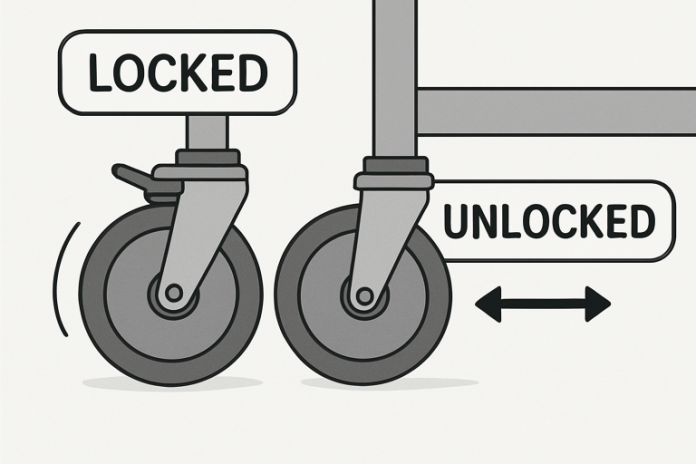
Introduction
Modern workplaces, healthcare settings, and industrial facilities all rely on mobility without sacrificing stability. Locking caster wheels play a vital role in achieving this balance, offering a seamless transition between unrestricted movement and secure positioning. Whether in manufacturing, hospitals, or commercial offices, choosing the right caster wheels is a critical step toward safer, more efficient, and more ergonomic operations. Without caster wheels that safely lock, everyday activities could become unsafe or cumbersome, and moving equipment effortlessly could pose unnecessary risks.
The value of locking caster wheels becomes evident when versatile movement must be paired with trustworthy immobilization. For institutions ranging from research labs to logistics centers, these wheels not only streamline daily routines but also reduce safety risks and protect valuable infrastructure. By ensuring both maneuverability and stability, locking casters are essential for safeguarding sensitive equipment, maintaining workflow continuity, and minimizing the risks of accidental equipment movement in dynamic environments.
Enhanced Stability and Control
Locking caster wheels are renowned for their ability to anchor equipment and carts precisely where they are needed. In environments like hospitals, locking casters on medical equipment and beds prevent unintentional movement during delicate procedures, enhancing both patient and staff safety. Similarly, in high-precision manufacturing, equipment stability is essential for accurate operations and quality control outcomes, making these wheels indispensable. Locking systems are engineered to withstand various weights and loads, giving users peace of mind during even the most detail-oriented tasks.
For businesses that must often relocate devices, locking casters foster a sense of control over the working environment. They allow for temporary but reliable positioning of heavy apparatus—such as copy machines, examination tables, portable machinery, or laboratory benches—preventing delays or disruptions. This increased level of control means tasks can be performed with greater precision, leading to improved results in production, patient care, or research.
Improved Safety Measures
Safety remains a priority in every workspace. Locking casters help prevent uncontrolled rolling that could cause injuries or damage. In factories and garages, heavy machinery and tool cabinets often feature locking casters to safeguard workers and equipment. This simple yet effective safety measure ensures compliance with strict workplace safety standards and reduces liability risks.
In facilities handling hazardous materials, stability is critical to preventing spills and protecting inventory safety. Locking caster wheels play a pivotal role in securing potentially dangerous or fragile loads, protecting not only employees but also the facility and its assets. This level of protection is essential for adhering to regulatory requirements and fostering a culture of proactive safety.
Versatility Across Applications
The adaptability of locking caster wheels is unmatched. They are commonly installed on desks, workstations, retail displays, medical trolleys, and industrial carts. Their dual function of offering mobility during transport and stability when stationary means one solution can meet a host of requirements across sectors. Schools, hospitality, and laboratory environments are among the many that leverage these wheels for operational flexibility and safety.
Locking casters are also increasingly popular in creative industries, such as art studios or production sets, where equipment and furniture often need to be reconfigured quickly and reliably. Their robust construction and diverse designs make them suitable for both indoor and outdoor applications. Choosing the correct type of locking caster—be it swivel or rigid, total-lock or directional-lock—depends on the specific needs and challenges of each environment, but the inherent flexibility remains a universal benefit.
Ergonomic Benefits
Heavy lifting and frequent equipment repositioning can place workers at risk of musculoskeletal injuries. With locking casters, staff can move objects, position them accurately, and lock them safely—all without excess strain. This ergonomic advantage not only improves worker comfort and productivity but also supports broader health and safety initiatives. According to the Centers for Disease Control and Prevention, reducing physical strain in the workplace directly reduces occupational injuries.
The ergonomic advantages extend beyond injury prevention. They help reduce overall fatigue and improve task flow by minimizing interruptions caused by misaligned or moving equipment. This creates an environment where employees can focus on their tasks and maintain efficiency throughout their shifts, which benefits both the workforce and the organization’s bottom line.
Floor Protection
Frequent equipment movement can wear down and damage sensitive flooring materials. High-quality locking caster wheels often use materials such as polyurethane or soft rubber. These protect flooring—hardwood, tile, laminate, or vinyl—by evenly distributing weight and absorbing shocks. As a result, facilities can reduce maintenance costs and preserve the appearance of their workspace floors for longer periods.
Soft-tread locking casters are ideal for environments concerned with cleanliness and aesthetics, as they do not scuff or mark surfaces. Additionally, by preventing sudden, unsupervised moves—such as carts rolling across the floor—locking casters reduce accidental dents, scrapes, and other damage often caused by heavy or sharp-edged objects. This, in turn, helps organizations maintain their professional appearance and ensures that high-traffic areas stay safe and tidy.
Noise Reduction
Beyond the risk of rolling equipment, the noise generated by moving wheels can disrupt workflow and increase stress in busy workplaces. By keeping equipment stationary when not in use, locking casters minimize these disturbances, contributing to a quieter, more productive environment. This benefit is especially valuable in hospitals, libraries, or office settings where maintaining a calm atmosphere supports better outcomes for staff and visitors alike.
In addition, advanced locking caster designs help absorb vibrations, lessening the impact of movement noises during use. This makes them an attractive solution for educational institutions, laboratories, or high-rise offices, where excessive noise can hinder productivity and concentration. The ability to both move equipment quietly and keep it silent when stationary enhances comfort for everyone present.
Conclusion
Investing in locking caster wheels offers tangible advantages for organizations across various types. These wheels amplify safety and streamline internal logistics, all while protecting staff health and workplace assets. As businesses seek to enhance both efficiency and safety, the strategic adoption of locking casters is a simple yet highly effective solution. For those seeking the optimal combination of mobility and stability, the future of seamless operations lies in the versatile design and robust performance of locking caster wheels.
With their proven effectiveness across multiple industries, it is clear that locking caster wheels are not just a convenience but a necessity for workplaces that prioritize both productivity and well-being. When it comes to fostering safe, efficient, and ergonomic environments, few solutions are as practical and impactful as the correct set of locking casters.



